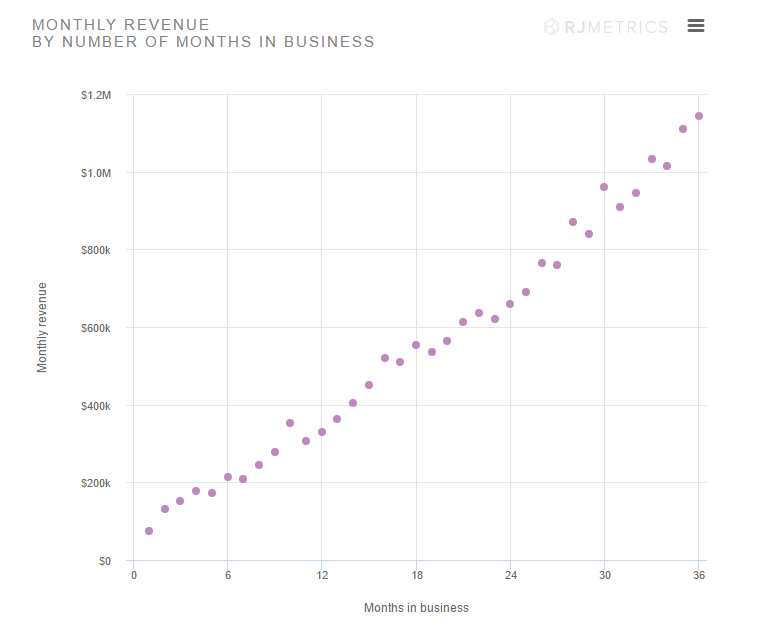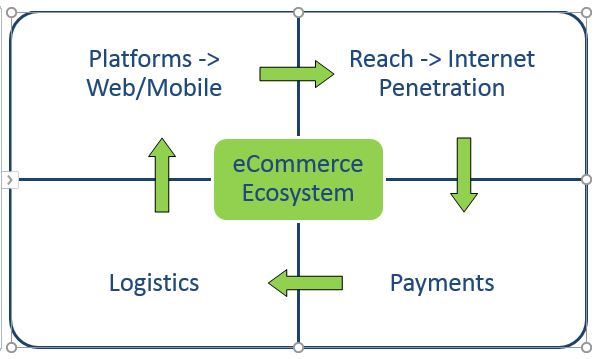
Around 1.3 billion population of the country opens a way for consumer companies to sell online in India. The middle-class Indian people are consuming the things wildly from online shopping business as the class rising vigorously. So, starting an eCommerce business in India is easier than setting up physical distribution since it is scalable. The growth rate of eCommerce reports that each year the eCommerce companies are creating new revenue records in online shopping business.
For example – according to industry sources; the leading three eCommerce companies earned almost US $ 4 Billion through selling products online during the Diwali season of 2016. It is a 300% rise from 2014.
The following chart manifests the average revenue for the first 36 months after an eCommerce store frees its doors.

Source: RJ Metrics
Getting into eCommerce gives us hope to shine in the future as the environment is in favor of us. Here are the four significant parts includes the eCommerce ecosystem.

Many people think that developing a website is an enormous work. And they just think only a software engineer or an IT company can build a website. So, it leads to looking for a good vendor to avoid consuming money and time. All don’t have a kind friend who is expert in IT and will assist you with the evaluation and project management. Therefore, most of us experience losing both money or time.
But, here comes the ready-made eCommerce platforms which can solve the above situations and support you with the vital network to run your online shopping business. With the help of these pre-built platforms, you can control, customize and change your website whenever you want. You can refresh the content of the website, and without the need of coding knowledge do little changes. The Platform of EWDC is made to use Magento, the world’s leading eCommerce platform. It helps you get your business up and sell online affordably and efficiently.
Also Read:
Due to selling products online, the Internet users in India grows with a 30% over the years. It is the moderate growth rate in the web users since 2006. To the digitization of villages, the current financial budget of 2017-2018 allotted Rs 10,000 crore.
The growth of getting into eCommerce includes both who visit online and converting users. Take a glance at the 2016 Diwali sales season. People from towns and municipalities energetically engaged in both the sales of general sections and other categories such as jewelry. And there is quite an adequate profit in the sales compared to last year.
Just from a data viewpoint –

On 8th November 2016, The Central Government of India demonetized the currencies of 500 and 1,000 rupees. During the process of demonetization, people got accustomed to it despite the change. Here, Digital wallets took a prominent place in small stalls along with expensive markets. So, the government began to stimulate cashless payments by giving cash back on even required products like fuel.
The practice of demonetization enabled both vendors and customers to go with technology in a friendly way. Both big and small retailers accepted digital payments and cards. Likewise, the government took initiatives to build a better situation for small traders to gain support to process cashless payments. Now, Indians are used to cards and digital payments by getting into eCommerce.
DHL eCommerce CEO Charles Brewer says – “Southeast Asia is the next eCommerce Wonderland”.
As DHL is starting an eCommerce business in India with the investment of US$ 75 Million, many other companies too like to follow the same thing to grow their warehouses, skills, and fleet in India. India has been experiencing considerable growth in Logistics as we witness the advent of five PL logistics suppliers in the country to assist online shopping businesses in reaching their customers in the furthest regions.
Selling products online with the help of digital support flourishes in the country as the consumer got a profound knowledge on the internet. Since the Internet will be the new market, it won’t lessen the significance of our offline store. To retain the offline stores, Amazon has started its offline stores by the name of Amazon Go. Despite, it shows the value of an omnichannel retailing and distribution. It is a fact that the cost of real estate goes high. So one has to accept that 90% of shopping still occurs offline and having an offline at present supports the customers to go online shopping business.
The uniqueness of owning a marketplace website enables you to collaborate with other sellers. So you can market their product or service and sell online on just one platform. Besides, from other retailers, you will get a commission through your website on all sale. Listing out your products or brand along with other sellers will make it easy for customers to compare prices and shop on your store with no hassle.
Here are some articles that provide you more information on how to build a marketplace eCommerce Platform:
We at EWDC assist you to grow selling online in India. If you have a plan of starting an eCommerce business in India or increase sales of your current business, we are delighted to help you out creating your online presence. Please reach out to us at info@ewdc.in and let’s begin the journey.